Analysis of Business Information System Use Case Diagram
VerifiedAdded on 2021/06/16
|5
|1416
|53
Homework Assignment
AI Summary
This assignment presents a use case diagram for the 'Sunrise Sushi' business, designed to manage customer orders and streamline business processes within an information system. The system aims to reduce manual effort, automate order processing, and improve efficiency in sushi delivery to retail outlets. The primary actor is the customer, with stakeholders including marketing administrators, foremen, accounts, warehouse clerks, and managers. The use case outlines preconditions like user login and post-conditions ensuring unique usernames and secure passwords. The main success scenario details the customer order process, from registration and item selection to payment and delivery management, including warehouse and foreman roles. Alternative flows address potential errors like incorrect data entry and order cancellations. The assignment includes a bibliography of relevant sources.
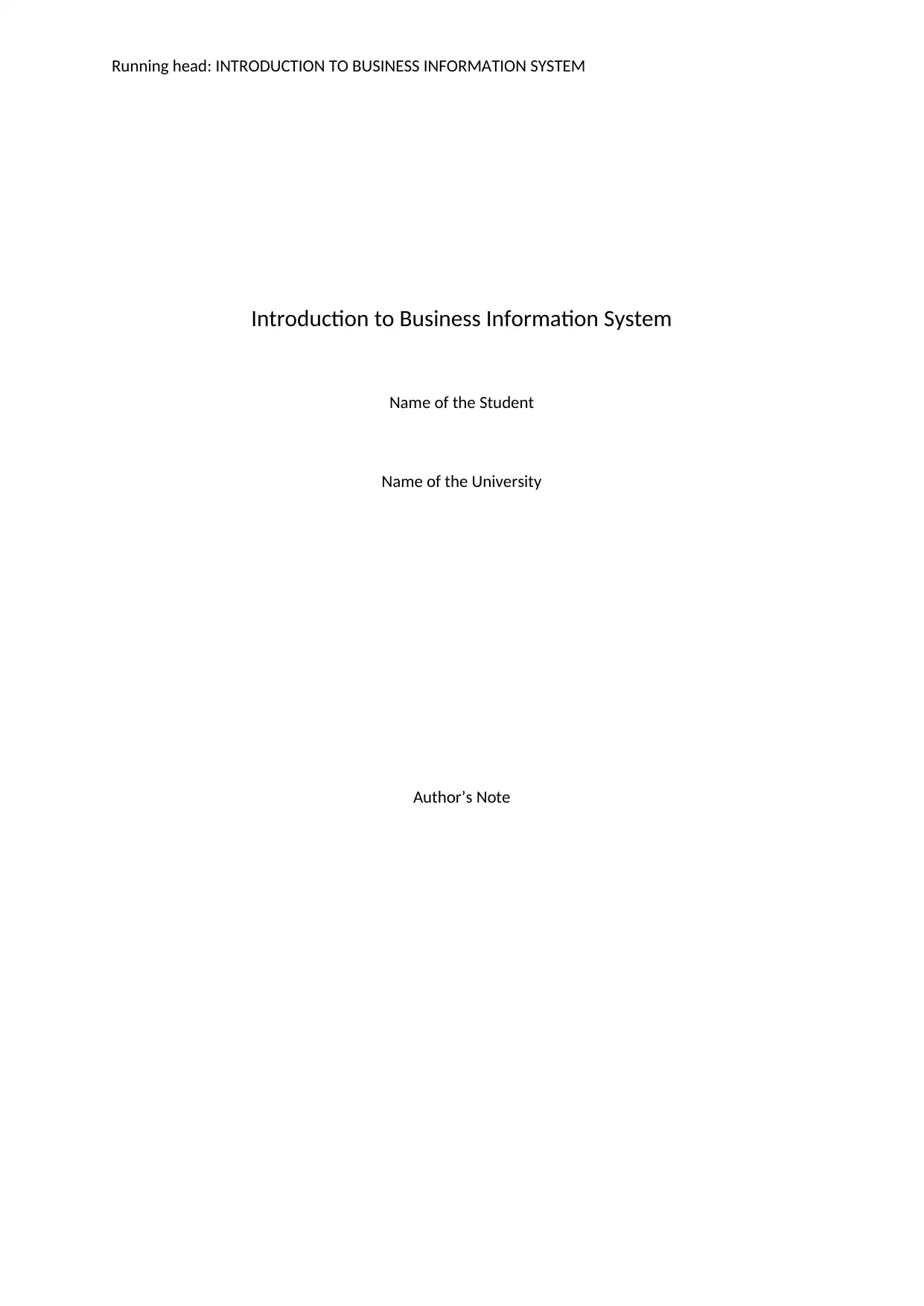
Running head: INTRODUCTION TO BUSINESS INFORMATION SYSTEM
Introduction to Business Information System
Name of the Student
Name of the University
Author’s Note
Introduction to Business Information System
Name of the Student
Name of the University
Author’s Note
Paraphrase This Document
Need a fresh take? Get an instant paraphrase of this document with our AI Paraphraser
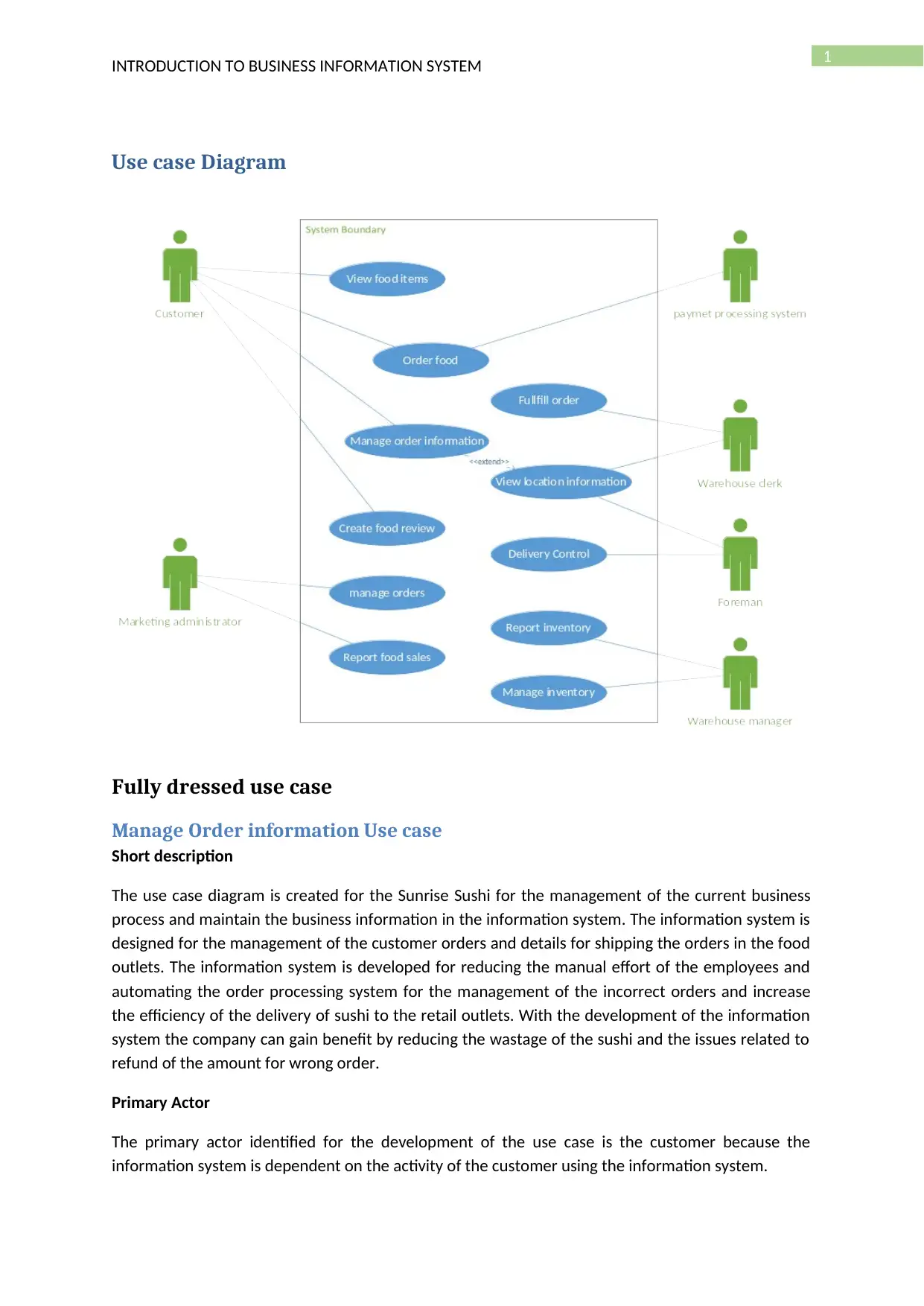
1
INTRODUCTION TO BUSINESS INFORMATION SYSTEM
Use case Diagram
Fully dressed use case
Manage Order information Use case
Short description
The use case diagram is created for the Sunrise Sushi for the management of the current business
process and maintain the business information in the information system. The information system is
designed for the management of the customer orders and details for shipping the orders in the food
outlets. The information system is developed for reducing the manual effort of the employees and
automating the order processing system for the management of the incorrect orders and increase
the efficiency of the delivery of sushi to the retail outlets. With the development of the information
system the company can gain benefit by reducing the wastage of the sushi and the issues related to
refund of the amount for wrong order.
Primary Actor
The primary actor identified for the development of the use case is the customer because the
information system is dependent on the activity of the customer using the information system.
INTRODUCTION TO BUSINESS INFORMATION SYSTEM
Use case Diagram
Fully dressed use case
Manage Order information Use case
Short description
The use case diagram is created for the Sunrise Sushi for the management of the current business
process and maintain the business information in the information system. The information system is
designed for the management of the customer orders and details for shipping the orders in the food
outlets. The information system is developed for reducing the manual effort of the employees and
automating the order processing system for the management of the incorrect orders and increase
the efficiency of the delivery of sushi to the retail outlets. With the development of the information
system the company can gain benefit by reducing the wastage of the sushi and the issues related to
refund of the amount for wrong order.
Primary Actor
The primary actor identified for the development of the use case is the customer because the
information system is dependent on the activity of the customer using the information system.
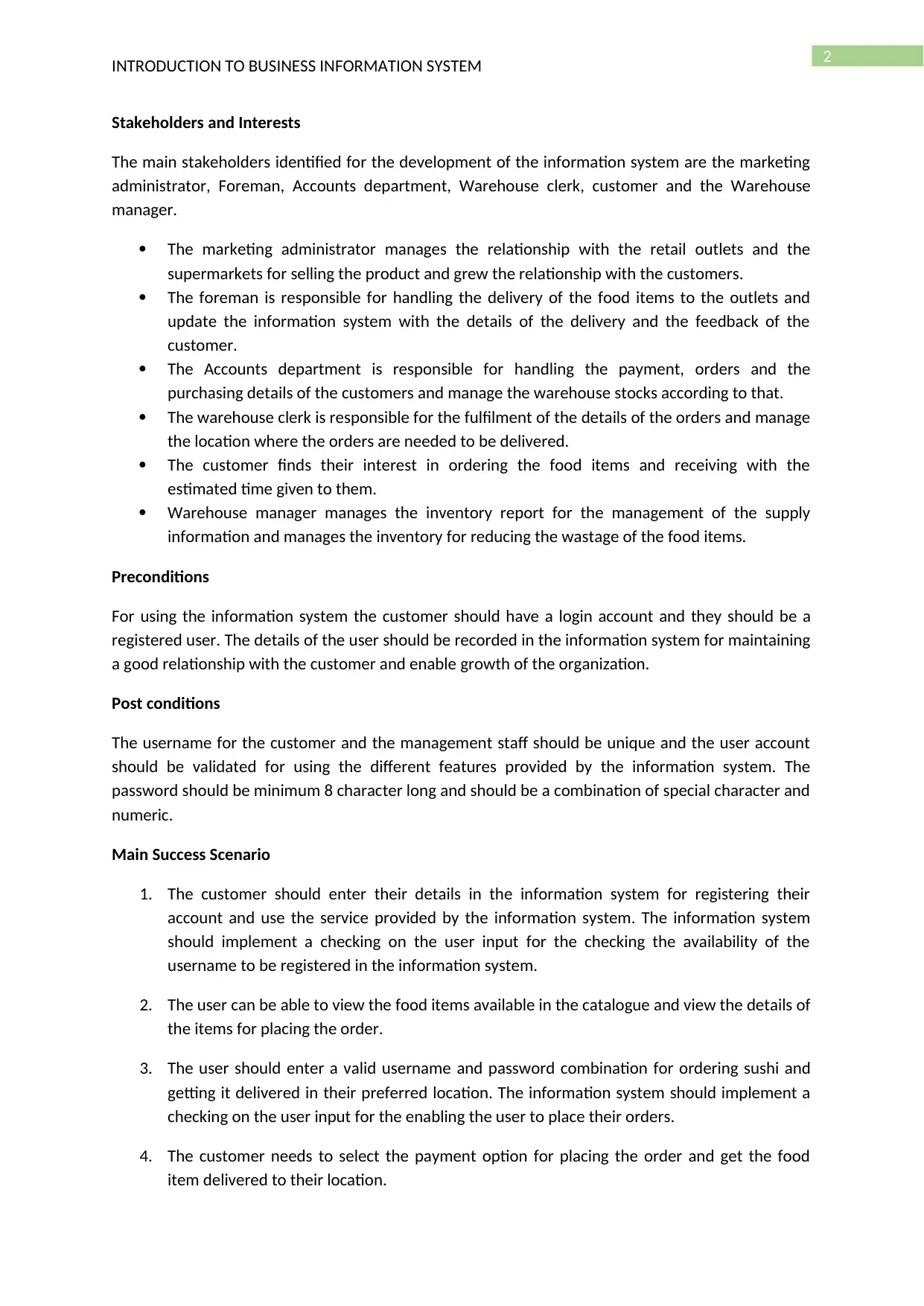
2
INTRODUCTION TO BUSINESS INFORMATION SYSTEM
Stakeholders and Interests
The main stakeholders identified for the development of the information system are the marketing
administrator, Foreman, Accounts department, Warehouse clerk, customer and the Warehouse
manager.
The marketing administrator manages the relationship with the retail outlets and the
supermarkets for selling the product and grew the relationship with the customers.
The foreman is responsible for handling the delivery of the food items to the outlets and
update the information system with the details of the delivery and the feedback of the
customer.
The Accounts department is responsible for handling the payment, orders and the
purchasing details of the customers and manage the warehouse stocks according to that.
The warehouse clerk is responsible for the fulfilment of the details of the orders and manage
the location where the orders are needed to be delivered.
The customer finds their interest in ordering the food items and receiving with the
estimated time given to them.
Warehouse manager manages the inventory report for the management of the supply
information and manages the inventory for reducing the wastage of the food items.
Preconditions
For using the information system the customer should have a login account and they should be a
registered user. The details of the user should be recorded in the information system for maintaining
a good relationship with the customer and enable growth of the organization.
Post conditions
The username for the customer and the management staff should be unique and the user account
should be validated for using the different features provided by the information system. The
password should be minimum 8 character long and should be a combination of special character and
numeric.
Main Success Scenario
1. The customer should enter their details in the information system for registering their
account and use the service provided by the information system. The information system
should implement a checking on the user input for the checking the availability of the
username to be registered in the information system.
2. The user can be able to view the food items available in the catalogue and view the details of
the items for placing the order.
3. The user should enter a valid username and password combination for ordering sushi and
getting it delivered in their preferred location. The information system should implement a
checking on the user input for the enabling the user to place their orders.
4. The customer needs to select the payment option for placing the order and get the food
item delivered to their location.
INTRODUCTION TO BUSINESS INFORMATION SYSTEM
Stakeholders and Interests
The main stakeholders identified for the development of the information system are the marketing
administrator, Foreman, Accounts department, Warehouse clerk, customer and the Warehouse
manager.
The marketing administrator manages the relationship with the retail outlets and the
supermarkets for selling the product and grew the relationship with the customers.
The foreman is responsible for handling the delivery of the food items to the outlets and
update the information system with the details of the delivery and the feedback of the
customer.
The Accounts department is responsible for handling the payment, orders and the
purchasing details of the customers and manage the warehouse stocks according to that.
The warehouse clerk is responsible for the fulfilment of the details of the orders and manage
the location where the orders are needed to be delivered.
The customer finds their interest in ordering the food items and receiving with the
estimated time given to them.
Warehouse manager manages the inventory report for the management of the supply
information and manages the inventory for reducing the wastage of the food items.
Preconditions
For using the information system the customer should have a login account and they should be a
registered user. The details of the user should be recorded in the information system for maintaining
a good relationship with the customer and enable growth of the organization.
Post conditions
The username for the customer and the management staff should be unique and the user account
should be validated for using the different features provided by the information system. The
password should be minimum 8 character long and should be a combination of special character and
numeric.
Main Success Scenario
1. The customer should enter their details in the information system for registering their
account and use the service provided by the information system. The information system
should implement a checking on the user input for the checking the availability of the
username to be registered in the information system.
2. The user can be able to view the food items available in the catalogue and view the details of
the items for placing the order.
3. The user should enter a valid username and password combination for ordering sushi and
getting it delivered in their preferred location. The information system should implement a
checking on the user input for the enabling the user to place their orders.
4. The customer needs to select the payment option for placing the order and get the food
item delivered to their location.
⊘ This is a preview!⊘
Do you want full access?
Subscribe today to unlock all pages.

Trusted by 1+ million students worldwide
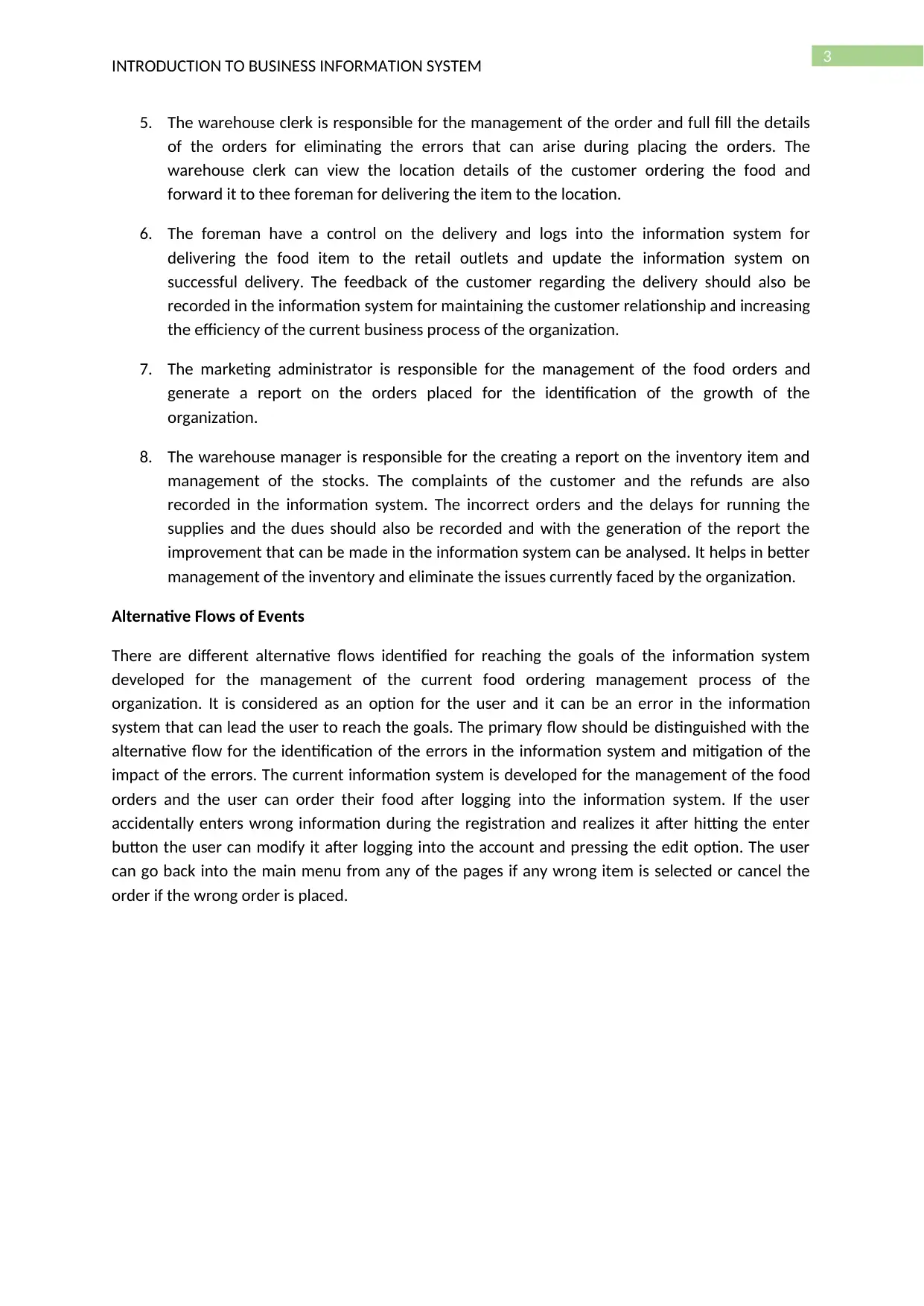
3
INTRODUCTION TO BUSINESS INFORMATION SYSTEM
5. The warehouse clerk is responsible for the management of the order and full fill the details
of the orders for eliminating the errors that can arise during placing the orders. The
warehouse clerk can view the location details of the customer ordering the food and
forward it to thee foreman for delivering the item to the location.
6. The foreman have a control on the delivery and logs into the information system for
delivering the food item to the retail outlets and update the information system on
successful delivery. The feedback of the customer regarding the delivery should also be
recorded in the information system for maintaining the customer relationship and increasing
the efficiency of the current business process of the organization.
7. The marketing administrator is responsible for the management of the food orders and
generate a report on the orders placed for the identification of the growth of the
organization.
8. The warehouse manager is responsible for the creating a report on the inventory item and
management of the stocks. The complaints of the customer and the refunds are also
recorded in the information system. The incorrect orders and the delays for running the
supplies and the dues should also be recorded and with the generation of the report the
improvement that can be made in the information system can be analysed. It helps in better
management of the inventory and eliminate the issues currently faced by the organization.
Alternative Flows of Events
There are different alternative flows identified for reaching the goals of the information system
developed for the management of the current food ordering management process of the
organization. It is considered as an option for the user and it can be an error in the information
system that can lead the user to reach the goals. The primary flow should be distinguished with the
alternative flow for the identification of the errors in the information system and mitigation of the
impact of the errors. The current information system is developed for the management of the food
orders and the user can order their food after logging into the information system. If the user
accidentally enters wrong information during the registration and realizes it after hitting the enter
button the user can modify it after logging into the account and pressing the edit option. The user
can go back into the main menu from any of the pages if any wrong item is selected or cancel the
order if the wrong order is placed.
INTRODUCTION TO BUSINESS INFORMATION SYSTEM
5. The warehouse clerk is responsible for the management of the order and full fill the details
of the orders for eliminating the errors that can arise during placing the orders. The
warehouse clerk can view the location details of the customer ordering the food and
forward it to thee foreman for delivering the item to the location.
6. The foreman have a control on the delivery and logs into the information system for
delivering the food item to the retail outlets and update the information system on
successful delivery. The feedback of the customer regarding the delivery should also be
recorded in the information system for maintaining the customer relationship and increasing
the efficiency of the current business process of the organization.
7. The marketing administrator is responsible for the management of the food orders and
generate a report on the orders placed for the identification of the growth of the
organization.
8. The warehouse manager is responsible for the creating a report on the inventory item and
management of the stocks. The complaints of the customer and the refunds are also
recorded in the information system. The incorrect orders and the delays for running the
supplies and the dues should also be recorded and with the generation of the report the
improvement that can be made in the information system can be analysed. It helps in better
management of the inventory and eliminate the issues currently faced by the organization.
Alternative Flows of Events
There are different alternative flows identified for reaching the goals of the information system
developed for the management of the current food ordering management process of the
organization. It is considered as an option for the user and it can be an error in the information
system that can lead the user to reach the goals. The primary flow should be distinguished with the
alternative flow for the identification of the errors in the information system and mitigation of the
impact of the errors. The current information system is developed for the management of the food
orders and the user can order their food after logging into the information system. If the user
accidentally enters wrong information during the registration and realizes it after hitting the enter
button the user can modify it after logging into the account and pressing the edit option. The user
can go back into the main menu from any of the pages if any wrong item is selected or cancel the
order if the wrong order is placed.
Paraphrase This Document
Need a fresh take? Get an instant paraphrase of this document with our AI Paraphraser
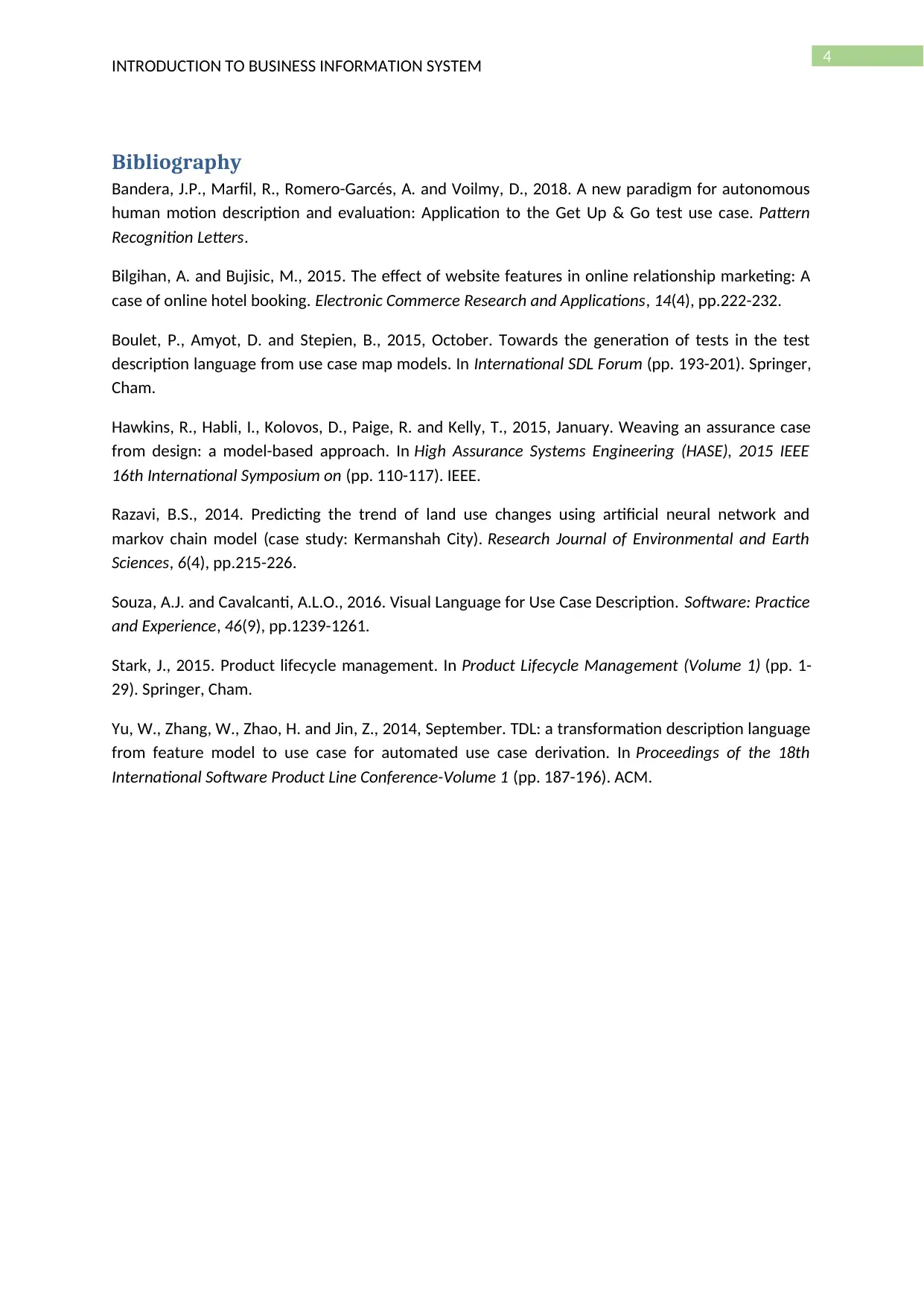
4
INTRODUCTION TO BUSINESS INFORMATION SYSTEM
Bibliography
Bandera, J.P., Marfil, R., Romero-Garcés, A. and Voilmy, D., 2018. A new paradigm for autonomous
human motion description and evaluation: Application to the Get Up & Go test use case. Pattern
Recognition Letters.
Bilgihan, A. and Bujisic, M., 2015. The effect of website features in online relationship marketing: A
case of online hotel booking. Electronic Commerce Research and Applications, 14(4), pp.222-232.
Boulet, P., Amyot, D. and Stepien, B., 2015, October. Towards the generation of tests in the test
description language from use case map models. In International SDL Forum (pp. 193-201). Springer,
Cham.
Hawkins, R., Habli, I., Kolovos, D., Paige, R. and Kelly, T., 2015, January. Weaving an assurance case
from design: a model-based approach. In High Assurance Systems Engineering (HASE), 2015 IEEE
16th International Symposium on (pp. 110-117). IEEE.
Razavi, B.S., 2014. Predicting the trend of land use changes using artificial neural network and
markov chain model (case study: Kermanshah City). Research Journal of Environmental and Earth
Sciences, 6(4), pp.215-226.
Souza, A.J. and Cavalcanti, A.L.O., 2016. Visual Language for Use Case Description. Software: Practice
and Experience, 46(9), pp.1239-1261.
Stark, J., 2015. Product lifecycle management. In Product Lifecycle Management (Volume 1) (pp. 1-
29). Springer, Cham.
Yu, W., Zhang, W., Zhao, H. and Jin, Z., 2014, September. TDL: a transformation description language
from feature model to use case for automated use case derivation. In Proceedings of the 18th
International Software Product Line Conference-Volume 1 (pp. 187-196). ACM.
INTRODUCTION TO BUSINESS INFORMATION SYSTEM
Bibliography
Bandera, J.P., Marfil, R., Romero-Garcés, A. and Voilmy, D., 2018. A new paradigm for autonomous
human motion description and evaluation: Application to the Get Up & Go test use case. Pattern
Recognition Letters.
Bilgihan, A. and Bujisic, M., 2015. The effect of website features in online relationship marketing: A
case of online hotel booking. Electronic Commerce Research and Applications, 14(4), pp.222-232.
Boulet, P., Amyot, D. and Stepien, B., 2015, October. Towards the generation of tests in the test
description language from use case map models. In International SDL Forum (pp. 193-201). Springer,
Cham.
Hawkins, R., Habli, I., Kolovos, D., Paige, R. and Kelly, T., 2015, January. Weaving an assurance case
from design: a model-based approach. In High Assurance Systems Engineering (HASE), 2015 IEEE
16th International Symposium on (pp. 110-117). IEEE.
Razavi, B.S., 2014. Predicting the trend of land use changes using artificial neural network and
markov chain model (case study: Kermanshah City). Research Journal of Environmental and Earth
Sciences, 6(4), pp.215-226.
Souza, A.J. and Cavalcanti, A.L.O., 2016. Visual Language for Use Case Description. Software: Practice
and Experience, 46(9), pp.1239-1261.
Stark, J., 2015. Product lifecycle management. In Product Lifecycle Management (Volume 1) (pp. 1-
29). Springer, Cham.
Yu, W., Zhang, W., Zhao, H. and Jin, Z., 2014, September. TDL: a transformation description language
from feature model to use case for automated use case derivation. In Proceedings of the 18th
International Software Product Line Conference-Volume 1 (pp. 187-196). ACM.
1 out of 5
Related Documents
Your All-in-One AI-Powered Toolkit for Academic Success.
+13062052269
info@desklib.com
Available 24*7 on WhatsApp / Email
![[object Object]](/_next/static/media/star-bottom.7253800d.svg)
Unlock your academic potential
Copyright © 2020–2025 A2Z Services. All Rights Reserved. Developed and managed by ZUCOL.


